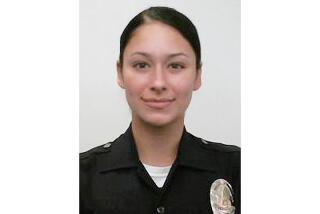Minnesota police officer convicted of murder in 911 caller death

- Share via
A Minneapolis police officer was convicted of third-degree murder Tuesday in the fatal shooting of an unarmed woman who approached his squad car minutes after calling 911 to report a possible rape behind her home, a rare instance of an officer being convicted after asserting he fired in a life-or-death situation.
Mohamed Noor was also found guilty of manslaughter in the July 2017 death of Justine Ruszczyk Damond , a 40-year-old dual citizen of the U.S. and Australia whose death bewildered and angered people in both countries.
Noor, a two-year veteran who had said he felt “called to serve” as a police officer and shifted from a career in business, was acquitted of the most serious charge of intentional second-degree murder. But he still faces a presumptive sentence of up to 17 years on the two convictions.
Noor was handcuffed and taken into custody immediately despite his attorney’s request that he be free on bond pending sentencing June 7. He showed no visible emotion and did not look back at his family, but his wife was crying.
Members of Damond’s family, also in the courtroom, showed no evident emotion.
Besides the tragic circumstances of the shooting, the case also carried elements of race and immigration. Damond, 40, was white; Noor, 33, is among the many Somali immigrants who settled in Minnesota after coming to America because of civil war in his home country.
Jurors deliberated for about five hours Monday and 6½ on Tuesday before reaching a decision.

Minnesota’s third-degree murder charge means causing the death of another through a dangerous act “without regard for human life but without intent to cause” death. The presumptive sentence is about 12½ years. Second-degree manslaughter, defined as creating unreasonable risk of causing death or great bodily harm to another through culpable negligence, has a presumptive sentence of about 4½ years.
Noor and his partner were rolling down the alley behind Damond’s home and checking out the 911 call just before the shooting. Noor testified that a loud bang on the squad car scared his partner and that he saw a woman raising her arm appear at his partner’s window. He said he fired to protect his partner’s life.
Prosecutors attacked Noor for shooting without seeing a weapon or Damond’s hands. They also questioned whether the loud bang was real. Neither Noor nor his partner, Matthew Harrity, mentioned it to investigators at the scene, with Harrity first mentioning it three days later in an interview with state investigators. Noor refused to talk to investigators.
The death of Damond, a life coach who was engaged to be married a month after the shooting, sparked outrage in both the United States and Australia. It also cost Minneapolis’ police chief her job and contributed to the electoral defeat of the city’s mayor a few months later.
Noor became a police officer with a mid-career switch from jobs in the business world. He testified that he became a police officer because he “wanted to serve,” and his hiring two years before the shooting was celebrated by Minneapolis leaders eager for a more diversified police force in a city with a large population of Somali immigrants.
He was fired after being charged.
Neither officer had a body camera running when Damond was shot, something Harrity blamed on what he called a vague policy that didn’t require it. Both men switched on their cameras in time to capture the aftermath, which included their attempts to save Damond with CPR. But Noor’s bullet hit her in a key abdominal artery, and a medical examiner testified that she lost so much blood so quickly that even faster medical care might not have saved her.
Prosecutors sought to raise questions about the way police and state investigators handled the aftermath. They played excerpts from body cameras worn by responding officers that revealed many officers turning them on and off at will; one officer could be heard on his camera at one point telling Noor to “keep your mouth shut until you have to say anything to anybody.” They also highlighted the lack of forensic evidence proving Damond touched the squad car.
But the case still came down to jurors’ assessment of whether Noor was justified in shooting, and they had only the officers’ testimony for a picture of the key moments. During his closing argument Monday, defense attorney Thomas Plunkett told jurors all that mattered was the “precise moment” in which Noor fired his gun and that they needed to consider whether Noor acted as a reasonable officer would act in the same circumstances. Prosecutor Amy Sweasy argued the shooting was not justified.
In his only public statement about the shooting, Noor testified that after he heard the loud noise, he saw fear in Harrity’s eyes and heard his partner yell, “Oh Jesus!” as he went for his weapon. Noor said Harrity was having difficulty pulling his gun from his holster. Noor said he then saw a woman in a pink shirt with blond hair appear at Harrity’s window and raise her right arm.
“I fired one shot,” he said, later adding: “My intent was to stop the threat and save my partner’s life.”
Harrity was pressed by prosecutors about why he didn’t fire. He said he hadn’t evaluated whether there was a threat by the time Noor fired. When Sweasy asked Harrity whether it would have been premature for him to use deadly force, he said: “Yes, with what I had.”
Both officers testified of their trust and high regard for each other. Both cried at points during their testimony.
The jury included 10 men and two women. Six of the jurors, including the two women, are people of color.
More to Read
Sign up for Essential California
The most important California stories and recommendations in your inbox every morning.
You may occasionally receive promotional content from the Los Angeles Times.













